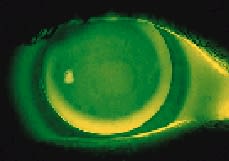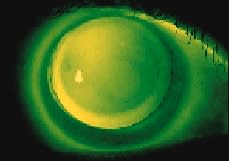A New RGP Multifocal for the Emerging Presbyope
BY CRAIG NORMAN, F.C.L.S.A.
OCT. 1997
It's important to use several different tools for presbyopic lens fitting. Here, we describe a potential new addition to your presbyopic fitting toolkit.
This year was a milestone for me professionally as I marked 20 years in practice. While reflecting on my career, I had a startling revelation -- your contact lens practice grows old with you!
Today, I spend 50 percent of my time with older (or if you prefer, maturing), less active, graying presbyopes who would love to regain their youth. Among the many challenges that I face every day is providing presbyopic patients with comfortable, quality vision with fitting ease and predictable results.
PARAMETERS AND INDICATIONS FOR NEW MULTI-ASPHERIC DESIGN
Polymer Technology recently introduced the Boston MultiVision RGP multifocal, a posterior surface multi-aspheric design manufactured exclusively in the Boston ES material. The 9.6mm diameter lens is available in 11 base curves from 7.3mm to 8.3mm. Distance powers range from -20.00D to +20.00D, with a nominal add to +1.50D. The manufacturer supplies the laboratories with pre-formed back surface lenses in each base curve, and the labs fabricate the spherical front surface power.
The multi-aspheric posterior curves are (Fig. 1):
- Elliptical optic zone (low eccentricity, provides distance vision)
- Hyperbolic zone (greater eccentricity, provides reading vision)
- Fillet curve (precision machined for junctionless transition between hyperbolic and ellipsoidal fitting curve)
- Elliptical fitting curve (fits mid-peripheral cornea, impacts edge lift, allows for alignment fit)
- Controlled edge curve (posterior formation of the edge design).
With a nominal add to +1.50D, the MultiVision design is clearly indicated for emerging presbyopes only. Select only those patients who are 50 years of age or younger and need +1.50D or less add. Don't attempt to prescribe this design for older presbyopes who need higher reading adds. Staying within this limitation helps simplify fitting.
SIMULTANEOUS VISION AND ALTERNATING VISION FROM ONE LENS
The posterior surface of this design combines an elliptical center optic zone with an adjacent hyberbolic reading area. When the lens is centered over the pupil for distance viewing, vision is simultaneous; when the patient looks down to read, the lens translates up for near. Thus, I would describe Boston MultiVision as a simultaneous vision, translating multifocal design.
Because simultaneous vision is pupil-dependent, lighting conditions that impact pupil size often have a negative effect on visual acuity. However, the simultaneous vision component of the MultiVision lens is not significantly impacted by pupil changes because of the relatively low eccentricity in the center optic zone.
Most aspheric multifocal RGPs employ the simultaneous vision concept where distance, intermediate and near images of equal intensity are simultaneously presented to the retina. Then, in theory, at a given distance the brain chooses the appropriate image. To achieve simultaneous vision, these designs usually have a posterior surface that is highly eccentric, utilizing numerous posterior surface construction strategies (Table 1).
|
Many of these posterior aspheric designs must be fit much steeper than the flattest corneal meridian to achieve the maximum amount of plus power in the mid-periphery. Often, we must adjust the base curve to increase the reading effect.
OPTIMAL FITTING RELATIONSHIP
Unlike some other posterior aspheric RGP multifocals, MultiVision should not be fit significantly steeper than K. It usually functions best when fit in alignment with the central and/or superior central portion of the cornea (Fig. 2). This alignment fitting means that we may design the lens similar to how we design single-vision contact lenses.
|
Alignment fitting also contributes to unobstructed vertical movement when the patient looks down, ensuring that the hyperbolic lens portion which provides the maximum reading component will be in front of the pupil.
MultiVision's unique posterior surface geometry provides an extremely wide fitting area across the mid-peripheral cornea. Thus, varying optic zone sizes, peripheral curve designs and/or overall diameters aren't necessary for an optimal fitting relationship.
FITTING TIPS AND TROUBLESHOOTING
Occasionally, a lens may not position exactly as predicted. Since the only fitting variable in the Boston MultiVision design is the base curve, steepening or flattening this parameter will correct lens decentration.
In the with-the-rule astigmat, a lens that decenters laterally usually indicates a flat fitting relationship. If the fluorescein pattern demonstrates central bearing (thus a loss of lens stability) simply steepening the base curve 0.1mm should improve centration. For corneal astigmatism greater than 1.50D, you may need an initial base curve one step steeper than normal.
If the fluorescein pattern demonstrates excessive mid-peripheral bearing (steep fitting relationship), then the lens may not achieve unobstructed movement along the vertical corneal meridian when the patient looks down to read. Choosing a base curve 0.1mm flatter should improve translation.
A flat lens can also position inferiorly, especially in a thicker plus lens design. Fluorescein pattern interpretation and evaluation of lid interaction will determine the cause of a low riding lens. Ensure that the lens-to-cornea fitting relationship is in alignment. If it's too flat, then steepen the base curve by 0.1mm. If the base curve relationship is adequate, yet the lens still positions downward, consider lenticulating (or changing the amount of lenticulation of) the anterior surface to increase upper lid interaction.
EDGE CLEARANCE
The unique back surface construction of Boston MultiVision results in consistent edge lift (clearance). The lens is mathematically calculated to achieve a 0.12mm axial edge lift throughout the base curve range, which is significantly higher than most other aspheric RGP lens designs (Fig. 3). The clearance increases tear flow underneath the periphery while decreasing the impingement that can occur with low edge lift designs. This consistent edge lift is a key factor in good patient comfort with the MultiVision design.
FIG. 3: NOTE THE RELATIVELY HIGH EDGE CLEARANCE OF THE BOSTON MULTIVISION LENS. |
Do not modify the back surface of the MultiVision lens. Due to its complex posterior surface geometry, any induced surface changes will compromise clinical performance by impacting the optical and fitting characteristics of the lens.
DIAGNOSTIC VS. EMPIRICAL FITTING
Diagnostic lens fitting enables us to judge initial patient response as well as evaluate the lens-to-cornea relationship, noting unusual topography, cornea diameter, pupil dynamics and the influence of lid position.
Although diagnostic fitting may take a little more time initially, it generally decreases the number of office visits. Since this design is available in only 11 base curves and one diameter, we can quickly identify appropriate candidates and rule out those patients for whom we can't achieve functional vision and/or a proper fitting relationship. In my opinion, the value-added perception of diagnostic fitting makes it an integral part of fitting premium contact lens products.
EITHER IT FITS OR IT DOESN'T
If you're unable to achieve an alignment fitting relationship and acceptable vertical translation with the initial diagnostic lens, simply choose the next steeper or flatter base curve for evaluation. (Choose direction depending on whether the lens demonstrates a flat or steep relationship.) Usually, this next lens will be acceptable. If not, the next steeper or flatter base curve should achieve desired fitting results.
At this point, if this lens still doesn't function as expected, you'll know that the patient is not a good candidate for the MultiVision design. These simple fitting procedures are great time-savers for both you and your patients.
Boston MultiVision is an excellent modality for the emerging presbyope. Its simple, straightforward fitting process quickly determines the efficacy when a low add design is indicated. CLS
Craig Norman is director of the contact lens section at South Bend Clinic, South Bend, Ind. He is a fellow of the Contact Lens Society of America, an advisor to the RGP Lens Institute and a paid consultant for Polymer Technology.





